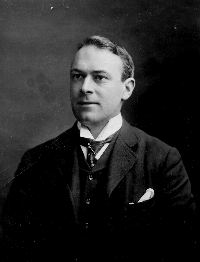Thomas Andrews
 |
Thomas Andrews Jr. was born in Belfast on February 7, 1873,
a son of the Right Hon. Thomas Andrews and Eliza Pirrie; he was also a
nephew of Lord Pirrie, principal owner of Harland & Wolff (the builders
of the Titanic.)
In 1884 Andrews entered the Royal Belfast Academical Institution, but
at the age of 16 he left school and entered Harland & Wolff shipbuilders
as a premium apprentice, gradually working his way up through various
departments. He eventually became the managing director of H & W
in charge of designing, and was familiar with every detail of the construction
of the firm's ships. In 1901 Andrews became a member of the Institution
of Naval Architects, and on June 24, 1908 he married Helen Reilly Barbour;
two years later a daughter, Elizabeth, was born to the young couple.
|
Thomas Andrews made a point of sailing with a team of mechanics
on the maiden voyages of the Adriatic, Oceanic and Olympic in order to observe
their operation and recommend improvements to future vessels slated to be
built by his firm. It was for this
very reason that Andrews planned to sail on Titanic's maiden voyage to America,
and the thirty-eight-year-old executive left his wife and daughter in Belfast
while he accompanied the vessel first to Southampton and, later, out onto
the vast expanse of
the North Atlantic. In his final letter to Mrs Andrews he expressed his satisfaction
with the new vessel: "The Titanic is now about complete and will I think
do the old Firm credit tomorrow when we sail".
At sea, Andrews had spent most of the journey making notes and assisting the
crew with minor difficulties as they got to know the new ship. Always a popular
man on these trips Chief Baker Charles Joughin had even baked Andrews a special
loaf of bread.
On the evening of April 14th, as usual, Bedroom Steward Henry Samuel Etches
arrived at 6:45 to help Andrews dress for dinner which he usually took with
Dr O'Loughlin the ship's surgeon. After dinner Andrews returned to his cabin
(A-36) to pore over blueprints and collate his notes. Andrews barely noticed
the collision and was unaware of any problem until Captain Smith sent a message
requesting his immediate presence on the bridge.Later, Saloon Steward James
Johnson described how he saw Andrews and Captain Smith touring the forward
part of the ship, they visited the flooding mail room and the squash court
which was also quickly filling with water. Back on the bridge Andrews broke
the news to Captain Smith that in view of the damage the ship had suffered
he did not expect her to stay afloat more than two hours.
During the liner's final hours Andrews wandered the decks encouraging passengers
to wear their lifebelts and to make their way to the boats. He was last seen
staring into space by the painting in the first class smoking room, his lifebelt
discarded.
The Making of History
| Owners | A
Grand Design | Construction | Sister
Ships - Olympic and Britannic
|
| Strict Segregation | Outdated
Lifeboat regulations | The Aura of Invincibility
|
| Launch | Specifications
|
Leaving for the New World
| Southampton | Southampton
- The New York and a Near Miss | Cherbourg
| Queenstown |
Provisions |
Passenger Lists
| First Class | Second
Class | Third Class |
Alphabtical list | Crew
| The Band |
Lifeboat Lists
| Lifeboats 1- 3 | Lifeboats
4 - 6 | Lifeboats 7-9 | Lifeboats
10-12 | Lifeboats 13 -16 |
Collapsibles |
Aftermath
| American Inquiry |
| Causes - An extract from February 1995 Edition
of Popular Mechanic |
Facts and Figures
| Harland and Wolff's 101 Answers to
the most asked questions about the RMS Titanic |